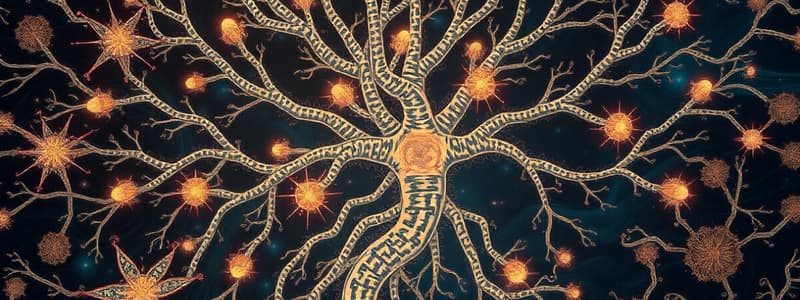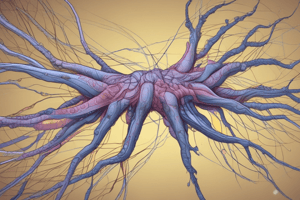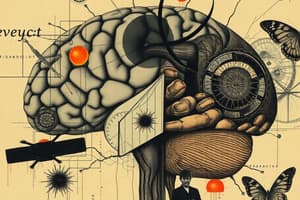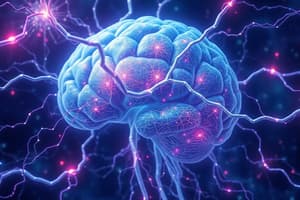Podcast
Questions and Answers
Which of the following is NOT a primary brain vesicle?
Which of the following is NOT a primary brain vesicle?
- Rhombencephalon
- Metencephalon (correct)
- Prosencephalon
- Mesencephalon
Which of the following structures is NOT part of the leptomeninges?
Which of the following structures is NOT part of the leptomeninges?
- Dura Mater (correct)
- Arachnoid
- Pia Mater
- None of the above
During which embryonic development stage do neural crest cells form?
During which embryonic development stage do neural crest cells form?
- Gastrulation
- Somitogenesis
- Neural induction/neurulation (correct)
- None of the above
Which of the following is NOT a function of the nervous system?
Which of the following is NOT a function of the nervous system?
Which of the following is NOT a type of nervous system cell?
Which of the following is NOT a type of nervous system cell?
Which of the following structures is responsible for carrying sensory information from the body to the spinal cord?
Which of the following structures is responsible for carrying sensory information from the body to the spinal cord?
Which of the following are glial cells found in the central nervous system?
Which of the following are glial cells found in the central nervous system?
What is the primary function of the ventral horn of the spinal cord?
What is the primary function of the ventral horn of the spinal cord?
Which of the following is NOT a characteristic of the thoraco-lumbar outflow of the autonomic nervous system?
Which of the following is NOT a characteristic of the thoraco-lumbar outflow of the autonomic nervous system?
Which of the following statements accurately describes the location of gray matter in the spinal cord?
Which of the following statements accurately describes the location of gray matter in the spinal cord?
Which of the following cell types is responsible for myelination of axons in the peripheral nervous system?
Which of the following cell types is responsible for myelination of axons in the peripheral nervous system?
Which of the following cranial nerves is NOT associated with the cranio-sacral outflow of the autonomic nervous system?
Which of the following cranial nerves is NOT associated with the cranio-sacral outflow of the autonomic nervous system?
What is the primary function of the central canal of the spinal cord?
What is the primary function of the central canal of the spinal cord?
Which of the following statements accurately describes the location of the cell bodies of motor neurons?
Which of the following statements accurately describes the location of the cell bodies of motor neurons?
Which of the following is a characteristic of the visceral efferent component of the autonomic nervous system?
Which of the following is a characteristic of the visceral efferent component of the autonomic nervous system?
The parasympathetic nervous system's preganglionic neurons originate from which spinal cord segments?
The parasympathetic nervous system's preganglionic neurons originate from which spinal cord segments?
Which of the following structures is NOT a part of the brainstem?
Which of the following structures is NOT a part of the brainstem?
Which cranial nerve(s) carry parasympathetic fibers?
Which cranial nerve(s) carry parasympathetic fibers?
What is the function of the arachnoid granulations?
What is the function of the arachnoid granulations?
Which of the following is involved in the coordination of voluntary movements?
Which of the following is involved in the coordination of voluntary movements?
Which of the following best describes the function of the pons?
Which of the following best describes the function of the pons?
What is the main function of the sympathetic nervous system?
What is the main function of the sympathetic nervous system?
Where are the cell bodies of sensory neurons located?
Where are the cell bodies of sensory neurons located?
Which ventricle is directly connected to the third ventricle via the cerebral aqueduct?
Which ventricle is directly connected to the third ventricle via the cerebral aqueduct?
Which of the following is NOT a function of the medulla oblongata?
Which of the following is NOT a function of the medulla oblongata?
What is the primary function of the prechordal plate in embryonic development?
What is the primary function of the prechordal plate in embryonic development?
What is the role of Wnt3 and brachyury in the formation of the primitive streak?
What is the role of Wnt3 and brachyury in the formation of the primitive streak?
Which of the following is NOT a consequence of gastrulation?
Which of the following is NOT a consequence of gastrulation?
What is the role of the notochord in embryonic development?
What is the role of the notochord in embryonic development?
What is the relationship between the primitive streak and the oropharyngeal membrane?
What is the relationship between the primitive streak and the oropharyngeal membrane?
What is the significance of the anterior visceral endoderm (AVE) in embryonic development?
What is the significance of the anterior visceral endoderm (AVE) in embryonic development?
After gastrulation, the remaining epiblast differentiates into various cell types. Which of the following IS NOT one of them?
After gastrulation, the remaining epiblast differentiates into various cell types. Which of the following IS NOT one of them?
Which of the following most accurately describes the process of neurulation?
Which of the following most accurately describes the process of neurulation?
What is the site of closure of the cranial neuropore during embryonic development?
What is the site of closure of the cranial neuropore during embryonic development?
Which of the following structures is NOT directly connected to the fourth ventricle?
Which of the following structures is NOT directly connected to the fourth ventricle?
Which brain vesicle develops into the lateral ventricles?
Which brain vesicle develops into the lateral ventricles?
What is the most common cause of hydrocephalus in newborns?
What is the most common cause of hydrocephalus in newborns?
What is the primary function of the choroid plexus?
What is the primary function of the choroid plexus?
What signaling pathway is blocked by BMP inhibitors in the undifferentiated ectoderm, preventing epidermal fate and allowing neural tissue to form?
What signaling pathway is blocked by BMP inhibitors in the undifferentiated ectoderm, preventing epidermal fate and allowing neural tissue to form?
Which of the following placodes is NOT directly involved in forming sensory ganglia for nerves of the pharyngeal arches?
Which of the following placodes is NOT directly involved in forming sensory ganglia for nerves of the pharyngeal arches?
During neurulation, which specific structure undergoes an epithelial-mesenchymal transformation and delaminates from the neural plate?
During neurulation, which specific structure undergoes an epithelial-mesenchymal transformation and delaminates from the neural plate?
Which cranial nerves are associated with parasympathetic ganglia derived from neural crest cells?
Which cranial nerves are associated with parasympathetic ganglia derived from neural crest cells?
Which structure secretes BMP antagonists to induce neural fate in the overlying ectoderm during neurulation?
Which structure secretes BMP antagonists to induce neural fate in the overlying ectoderm during neurulation?
Besides contributing to sensory ganglia, what other structures are derived from neural crest cells?
Besides contributing to sensory ganglia, what other structures are derived from neural crest cells?
Which of the following cell types is NOT derived from neural crest cells?
Which of the following cell types is NOT derived from neural crest cells?
Which of the following statements BEST describes the role of BMP signaling in neural development?
Which of the following statements BEST describes the role of BMP signaling in neural development?
Flashcards
Nervous System
Nervous System
The organ system responsible for transmitting signals between different body parts.
Meninges
Meninges
Three protective membranes covering the brain and spinal cord: dura mater, arachnoid, and pia mater.
Neural Tube Defects
Neural Tube Defects
Congenital malformations that occur when the neural tube fails to close properly, affecting brain and spine development.
Primary Brain Vesicles
Primary Brain Vesicles
Signup and view all the flashcards
Neural Crest Cells
Neural Crest Cells
Signup and view all the flashcards
Gastrulation
Gastrulation
Signup and view all the flashcards
Primitive Streak
Primitive Streak
Signup and view all the flashcards
Notochord
Notochord
Signup and view all the flashcards
Prechordal Plate
Prechordal Plate
Signup and view all the flashcards
Anterior Visceral Endoderm (AVE)
Anterior Visceral Endoderm (AVE)
Signup and view all the flashcards
Neural Induction
Neural Induction
Signup and view all the flashcards
Somitogenesis
Somitogenesis
Signup and view all the flashcards
Definitive Ectoderm
Definitive Ectoderm
Signup and view all the flashcards
Gray Matter
Gray Matter
Signup and view all the flashcards
White Matter
White Matter
Signup and view all the flashcards
Neurons
Neurons
Signup and view all the flashcards
Glial Cells
Glial Cells
Signup and view all the flashcards
Dorsal Horn
Dorsal Horn
Signup and view all the flashcards
Ventral Horn
Ventral Horn
Signup and view all the flashcards
Pseudounipolar Neurons
Pseudounipolar Neurons
Signup and view all the flashcards
Somatic Afferent
Somatic Afferent
Signup and view all the flashcards
Visceral Efferent
Visceral Efferent
Signup and view all the flashcards
Autonomic Nervous System
Autonomic Nervous System
Signup and view all the flashcards
Secondary Brain Vesicles
Secondary Brain Vesicles
Signup and view all the flashcards
Telencephalon
Telencephalon
Signup and view all the flashcards
Diencephalon
Diencephalon
Signup and view all the flashcards
Hydrocephalus
Hydrocephalus
Signup and view all the flashcards
Cerebral Aqueduct
Cerebral Aqueduct
Signup and view all the flashcards
Preganglionic Neuron
Preganglionic Neuron
Signup and view all the flashcards
Postganglionic Neuron
Postganglionic Neuron
Signup and view all the flashcards
Sympathetic Nervous System
Sympathetic Nervous System
Signup and view all the flashcards
Parasympathetic Nervous System
Parasympathetic Nervous System
Signup and view all the flashcards
Forebrain
Forebrain
Signup and view all the flashcards
Cerebellum
Cerebellum
Signup and view all the flashcards
Cranial Nerves
Cranial Nerves
Signup and view all the flashcards
Ventricles of the Brain
Ventricles of the Brain
Signup and view all the flashcards
Thalamus
Thalamus
Signup and view all the flashcards
Ectodermal Placodes
Ectodermal Placodes
Signup and view all the flashcards
Bone Morphogenetic Proteins (BMPs)
Bone Morphogenetic Proteins (BMPs)
Signup and view all the flashcards
Notochord role in neural induction
Notochord role in neural induction
Signup and view all the flashcards
Neurulation process
Neurulation process
Signup and view all the flashcards
Neural crest derivations
Neural crest derivations
Signup and view all the flashcards
Neural derivatives of neural crest
Neural derivatives of neural crest
Signup and view all the flashcards
Sensory ganglia of cranial nerves
Sensory ganglia of cranial nerves
Signup and view all the flashcards
Epithelial-mesenchymal transformation
Epithelial-mesenchymal transformation
Signup and view all the flashcards
Study Notes
Basics of the Nervous System
- Division
- Types of cells
- Anatomy
Early Embryonic Development
- Gastrulation
- Somitogenesis
- Neural induction/neurulation
- Neural crest cells
- Neural tube defects
Development of the Brain Vesicles
- Development of the Primary Brain Vesicles
- Development of the Secondary Brain Vesicles
Nervous System Overview
- Enclosed by meninges (Dura Mater, Leptomeninges - Arachnoid & Pia Mater)
- Central Nervous System (CNS): Brain and Spinal cord
- Receives and processes sensory information, initiates responses, stores memories, generates thoughts, and emotions (brain) Conducts signals to and from the brain, controls reflex activities (spinal cord)
- Peripheral Nervous System (PNS): Cranial nerves, Spinal nerves, Sensory neurons, Motor neurons, Sensory ganglia, and Autonomic ganglia
- Cell body of neurons
- Somatic nervous system- Controls voluntary movements
- Autonomic nervous system- Smooth muscle, cardiac muscle and glandular epithelium
- Sympathetic division ("Fight or Flight")- T1 - L2/3
- Parasympathetic division ("Rest or Digest")- Cranial nerves III, VII, IX, X, S2-S4 Pelvic splanchnic nn
- Gray Matter- Cell body of neurons (within nuclei), Glia cells,
- White Matter- Axons (tracts), Glia cells
Cells of the Nervous System
- Neurons: the main cells of the nervous system (NS), their cell bodies are located in the gray matter of the CNS (central nervous system) and within the ganglia of the PNS (peripheral nervous system)
- Glial Cells:
- CNS: Astrocytes, Oligodendrocytes, Ependymal cells, Microglia, and Radial Glia cells (embryonic)
- PNS: Schwann cells (PNS), and Satellite cells (PNS)
Types of Neurons (Morphological Classification)
- Bipolar
- Multipolar
- Pseudounipolar
Types of Neurons (Functional Classification)
- Sensory neuron
- Interneuron
- Motor neuron
The Spinal Cord
- Ventral horn (Anterior gray column)
- Dorsal horn (Posterior gray column)
- Central canal
- Ventral groove
- Motor neurons are located in the ventral horn, while sensory neurons are located outside the spinal cord, inside dorsal root ganglia
Autonomic Nervous System
- Functional components: Somatic afferent (skin, muscle, tendon, joint capsule); Visceral afferent (smooth muscle, glands); Visceral Efferent (autonomic ganglia); Somatic Efferent (skeletal muscles)
- SA, VA, and SE run the full length of the cord.
- VE - T1 – L2/3 (Sympathetic)
- S2 - S4 (Parasympathetic)
Autonomic Nervous System
- Two efferent neurons in series:
- Preganglionic neuron (inside CNS)
- Postganglionic neuron (outside CNS, in autonomic ganglion)
Autonomic Nervous System
- Sympathetic and parasympathetic divisions
The Brain (Prosencephalon)
- Telencephalon: Cerebral cortex, basal ganglia, coordination of voluntary movements,
- Diencephalon: Thalamus, hypothalamus, epithalamus
- Midbrain (Mesencephalon): Colliculi (visual & auditory processing), Pons (neuron pathways), Cerebellum (motor control), Medulla (many autonomic functions)
The Brain (Rhombencephalon)
- Metencephalon: pons, cerebellum
- Myelencephalon: medulla
Ventricles of the Brain
- Spaces filled with cerebrospinal fluid (CSF)
- Lateral Ventricles (right and left)
- Third ventricle
- Fourth ventricle
- Passageways connecting internal brain vesicles and subarachnoid space surrounding the brain and spinal cord
- Communications between CSF-filled spaces and blood-filled dural venous sinuses through arachnoid granulations
Cranial Nerves
- 12 pairs (motor/sensory/mixed) Most arise in the brainstem (except CN I & II)
- Motor: nuclei located in the brain
- Sensory: neurons located outside the brain (sensory ganglia)
- Parasympathetic fibers carried along with some cranial nerves (III, VII, IX, X)
Gastrulation
- Formation of the primitive streak
- The first epiblast cells to migrate to the primitive streak become endoderm
- Epiblast cells that migrate further into the primitive streak become mesoderm
- The remaining epiblast becomes ectoderm
The primitive streak doesn't reach the most anterior region of the embryo. Why?
- Wnt3 and Brachyury induce formation and anterior extension of the primitive streak
- The future head region has a signaling center called Anterior Visceral Endoderm (AVE).
- AVE blocks Wnt3 and brachyury signaling, preventing cranial expansion of the primitive streak
Gastrulation and Cell Fates
- Hypoblastic cells move toward the oropharyngeal membrane, creating the prechordal plate
Prechordal Plate
- Location: rostral to notochord, posterior to the oropharyngeal membrane and AVE
- Function: signaling center that induces brain development
Notochord
- Epiblast cells form the notochord along the embryo's midline
- Forms a midline axis, basis of axial skeleton
- Induces formation and folding of the neural plate
- Contributes to dorso-ventral patterning of the neural tube
After Gastrulation
- Remaining epiblast cells differentiate into surface ectoderm, neural plate, neural crest cells, and ectodermal placodes (olfactory, nasal, lens, otic, and epiphyrangeal)
- Placodes assist neural cells in forming sensory ganglia of cranial arches (V-VII-IX-X)
Neural Induction
- Notochord secretes BMP (Bone Morphogenetic Protein) antagonists (Chordin, Noggin, Follistatin, and Nodal)
- These block BMP signaling in the undifferentiated ectoderm, allowing neural tissue to form
Neurulation
- Neurogenic factors released by the notochord induce the overlying ectoderm to form the neural plate.
- Neural plate folds to form the neural tube.
- Neural crest cells undergo epithelial-mesenchymal transitions and delaminate from the neural plate.
Neural Crest and Derivatives
- Migratory, pluripotent cells
- Contribute to structures in the head and neck
- Neural derivatives: sensory ganglia of spinal nerves, sensory ganglia of cranial nerves, sympathetic ganglia, parasympathetic ganglia, adrenal medulla (chromaffin cells)
Neural Crest Cells: Non-neural derivatives
- Glia cells in PNS: Schwann cells and satellite cells
- Melanocytes, odontoblasts, cementoblasts
- Skeletal components in the pharyngeal arches (cartilage & bones)
- Ciliary and pupillary muscles
- Leptomeninges: arachnoid and pia mater
- Migration guided by signals from non-neuronal tissue (somites)
Somitogenesis
- Neurulation and somitogenesis occur concomitantly
- Cells migrating through the node (posteriorly) and cranial part of the primitive streak form paraxial mesoderm
- Paraxial mesoderm cells coalesce to form somites.
Fate of the Somite
- Dermomyotome (dermatome: forms dermis, myotome: forms muscles)
- Sclerotome (forms vertebrae and intervertebral disc (IVD))
Neural Plate Formation and Neurulation
- Neural tube begins folding and fusing in the occipito-cervical region
- Forms cranial and caudal neuropores
Neural Tube Defects
- NTDs: diverse set of birth defects that involve the neural tube and/or associated structures
- Result from failure of neural tube or neuropores to close properly
- Spina bifida: defects in the spinal cord/caudal neuropore
- Anencephaly: defects in the cranial neuropore (fatal)
- Causes: folic acid deficiency, genetic predisposition, teratogens (other factors: obesity, smoking, hyperthermia)
- Diagnosis: high levels of alpha-fetoprotein in amniotic fluid
Skull defects and encephaloceles
- Defects in skull bone ossification can result in meningoceles, encephalomeningoceles, and encephalomeningohydroceles.
- The squamous part of the occipital bone is most often involved
- Severity depends on the size of the bony defect
Development of the Primary Brain Vesicles
- Following neural induction, the cephalic end of the neural tube shows three dilations: prosencephalon, mesencephalon, and rhombencephalon
Development of the Secondary Brain Vesicles
- At 5 weeks, the primary vesicles develop into 5 secondary vesicles: telencephalon, diencephalon, mesencephalon, metencephalon, and myelencephalon
Development of the Secondary Brain Vesicles
- The lumen of the developing spinal cord is continuous with the brain vesicles.
- They become filled with cerebrospinal fluid (CSF) produced by choroid plexus.
Hydrocephalus
- Accumulation of CSF in the brain
- Enlarges ventricles
- Common cause: aqueduct blockage
Summary
- Sequential development of brain vesicles
Studying That Suits You
Use AI to generate personalized quizzes and flashcards to suit your learning preferences.




